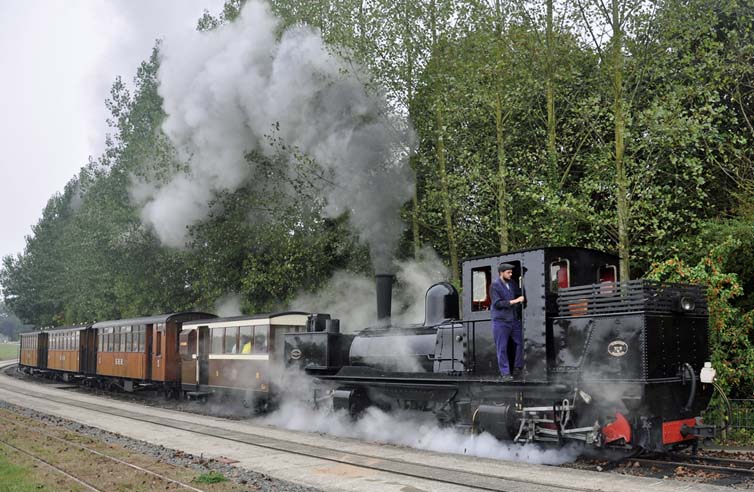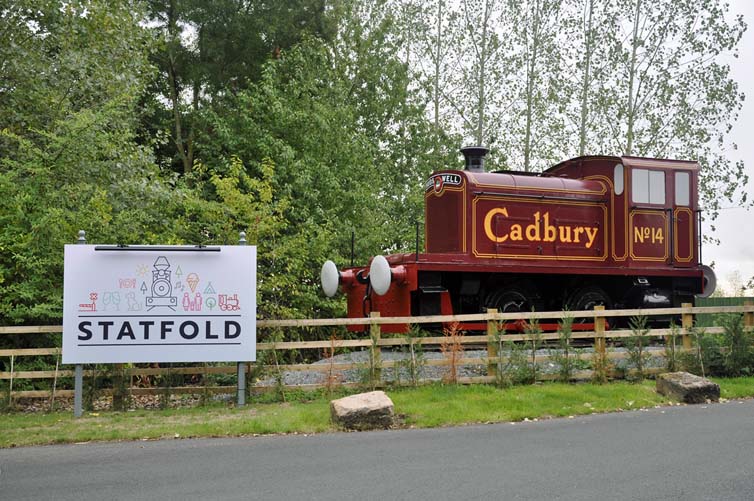 |  INTRODUCTION |
K1 - is considered to be the first Garratt 0-4-0+0-4-0T built in 1909 by Beyer Peacock & Company for the Tasmanian Government Railways. It's a compound locomotive with two high-pressure cylinders on the rear engine, and a pipe leading to two larger low-pressure cylinders on the front engine. Both sets of cylinders were placed facing each other inside their engine units, rather than facing out as in all other Garratts. This was a problem on the rare warm days on the West Coast Range in Tasmania as one pair of cylinders was under the cab making the cab uncomfortably hot.
Background image - After the Tasmanian line closed in 1929 the boiler of K1 was sold to a sawmill, then in 1947 K1 was sold to its builder Beyer Peacock & Company with the boiler and boiler cradle of K2 attached and repatriated back to England. Beyer Peacock & Co. closed in 1966 so K1 was sold to the Ffestiniog Railway for £1,500 after an appeal for funds. However, it was too tall and wide for use within Ffestiniog's restricted loading gauge, so after ten years of storage at Porthmadog, it was lent to the National Railway Museum (NRM) where it was cosmetically restored. As the Welsh Highland Railway (WHR) rebuilding project reached fruition K1's potential for the line was recognised and in 1995 it left NRM. A new boiler was found to be required. Parts were restored at various locations, with K1 reassembled at Boston Lodge. After conversion to oil-firing, it steamed again in 2004 and finally received HM Railway Inspectorate approval in September 2006 to haul trains. A conversion back to coal firing was completed in August 2007 together with some other work. It entered regular passenger service in October 2007. In 2014, K1's boiler certificate expired and it was withdrawn for overhaul. A full boiler shell exam was required. However, because the locomotive did not meet the operational requirements of the WHR (it cannot haul the passenger loads required), and with the WHR's workshops fully committed to other overhaul projects, in 2019 it moved to the Statfold Barn Railway for a period of ten years. A boiler overhaul was started in January 2020. K1 is shown operating on the Statfold Barn Railway - 11 Sep 2022 William Slim.
Background image - After the Tasmanian line closed in 1929 the boiler of K1 was sold to a sawmill, then in 1947 K1 was sold to its builder Beyer Peacock & Company with the boiler and boiler cradle of K2 attached and repatriated back to England. Beyer Peacock & Co. closed in 1966 so K1 was sold to the Ffestiniog Railway for £1,500 after an appeal for funds. However, it was too tall and wide for use within Ffestiniog's restricted loading gauge, so after ten years of storage at Porthmadog, it was lent to the National Railway Museum (NRM) where it was cosmetically restored. As the Welsh Highland Railway (WHR) rebuilding project reached fruition K1's potential for the line was recognised and in 1995 it left NRM. A new boiler was found to be required. Parts were restored at various locations, with K1 reassembled at Boston Lodge. After conversion to oil-firing, it steamed again in 2004 and finally received HM Railway Inspectorate approval in September 2006 to haul trains. A conversion back to coal firing was completed in August 2007 together with some other work. It entered regular passenger service in October 2007. In 2014, K1's boiler certificate expired and it was withdrawn for overhaul. A full boiler shell exam was required. However, because the locomotive did not meet the operational requirements of the WHR (it cannot haul the passenger loads required), and with the WHR's workshops fully committed to other overhaul projects, in 2019 it moved to the Statfold Barn Railway for a period of ten years. A boiler overhaul was started in January 2020. K1 is shown operating on the Statfold Barn Railway - 11 Sep 2022 William Slim.
The Statfold Barn Railway is a two-foot gauge, and some 2 foot 6 inch mixed gauge, railway located near Tamworth in Staffordshire, England, United Kingdom. It's actually more than a railway and somewhat agin to a museum and amusement park with their automobile and heritage vehicle events with amusement rides. The railway is 1 1/2 miles in length in an out and back pattern those familiar with model railroading will recognise. A short tramline parallels the track near the entrance to the site. The railway began as a small garden railway by engineering entrepreneur Graham Lee and his wife Carol. Over the years it evolved into the Statfold Narrow Gauge Museum Trust with a collection of over 100 locomotives, vehicles, and ephemera. The railway has an extensive workshop where locomotives are built and restored.
Wikipedia contains a substantial list of their steam, diesel, petrol, electric, compressed air locomotives, rail cars, and tram.
Statfold Barn near Tamworth Staffordshire England United Kingdom - Standard gauge Cadbury number 14 rests at the entrance to the Statfold Barn site. It was built by Hudswell Clarke in 1955 with a Gardner 107HP engine for work at Cadbury's Moreton Factory in September 1956. It was a Diesel Mechanical locomotive weighing 20 Tons with a top speed of 14 mph capable of hauling 200 Tons but is now inoperative.




